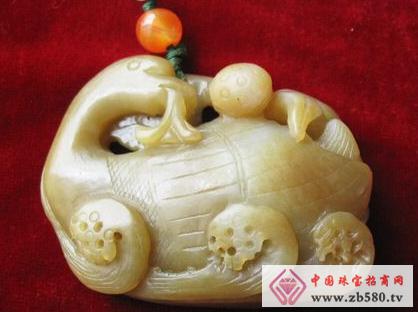
The ancient jade is very easy to change color due to changes in time and environment. Generally, the color change that occurs after jade is made is as follows:
1. Oxidation of jade in the air. When jade is exposed to the air, it will be weathered. The main change is oxidation. For example, when people are in jade, it is often necessary to guess the jade color through jade, and the outer skin of most jade is inconsistent with the internal jade. From the perspective of petrology, the outer skin of the jade and the inner core are the same kind of rock, and the difference in color is caused by weathering. A geologist at Taiwan University encountered this situation when collecting jade in the riverbed. The upper part of the jade was exposed to the air with a ochre film, and the lower part was immersed in the river for a long time, showing the original color of jade. These conditions indicate that the jade material will change in weather or color, but the weathering and color change will vary depending on the fineness of the material. The weathered jade will produce less weathering or no Changes, loose textures produce greater changes. There are also a lot of jade seeds collected, the surface is radiant, and there is almost no change in color. The process of color change caused by the oxidation of jade material in the air is very slow. Some jade articles are placed in the natural state for hundreds of years, and the surface color is almost unchanged. Therefore, the Palace Museum has a number of Ming Dynasty jade belt plates, some of which are white jade light. The plain plate, which may be the works of the early Ming Dynasty, has a dark surface and a partially grayish yellow color, which should be the color change caused by the erosion of oxygen-containing gas in the air. According to this, we can infer that the jade is placed in the natural state for about five hundred years, and some jade surfaces may produce identifiable tiny discoloration, which often occurs in some white jade and sapphire products.
2. The color change produced by jade in the tomb. Most of the ancient jade articles unearthed in the ancient tombs have color changes. The reasons for the changes may be caused by the chemical components contained in the burial objects in the tomb, and may also be caused by the erosion of chemical components in the soil. The ancients have given great attention to this problem, which is called "twilight", meaning that some ingredients in the tomb or in the soil infiltrated or broke into the jade, causing the jade to change color, borrowed by modern people. The ancient language also used the term "twilight".
3, artificial disk. After the jade is made, it is rubbed by the user for a certain period of time, or with the human body for a long time. The surface will be more lustrous and the transparency will be slightly stronger, especially the ancient jade that has entered the soil. After the panning, the color will change. Some of the red color of jade is the 'red red' that gradually changes after entering the soil and changing its shape.
4. Artificial dyeing. Artificial dyeing of jade is a very ancient process. As long as there is a pursuit of the color of ancient jade, there is the possibility of artificial dyeing jade. The original artificial jade is only to pursue the beauty of jade. With the appearance of pseudo-ancient jade, jade dyeing has become an important means of antique and old. According to the material, the artificial jade method has been adopted in the manufacture of antique jade in the Song Dynasty. This method has important development in the Ming and Qing dynasties. Today, the pseudo-ancient jade is flooded and artificial dyeing becomes fake. The old main means. The following is a brief summary of the identification of several major jade colors: in general, the true color of jade is easier to identify, mainly in colors such as cyan, white, black, yellow, and green, while the coloration of artificial dyeing and jade is very difficult. Identification, in the identification of jade, often encountered artificial staining, ochre and jade color similar to each other, which requires the jade to seriously distinguish. Observation is discernible.
Knitting Fabric,Jersey Knit Fabric,Cotton Jersey Fabric,Double Knit Fabric
Shaoxing Yiyang Textiles Co.,Ltd , https://www.yiyangfabrics.com